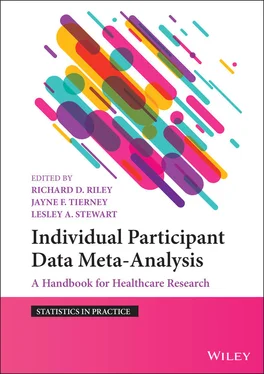This IPD can be used to produce aggregate data for each trial, as shown in the table on the following page.(b) Aggregate data
Now each row corresponds to a particular trial, and each column is a trial‐level variable containing aggregated data values such as the total number of particulars and the mean age in each group.Trial IDNumber of participantsMean age(years)Mean SBP before treatment(mmHg)Mean SBP at 1 year(mmHg)Treatment effect on SBP at 1 year adjusted for baseline(treatment minus control)ControlTreatmentControlTreatmentControlTreatmentControlTreatmentEstimate (variance)175070442.3642.17153.05153.88139.75132.54–6.53 (0.75)219913869.5769.71191.55188.30179.89164.67–13.81 (4.95)(rows for trials 3 to 9 omitted for brevity)102297239870.2170.26173.94173.75165.24154.87–10.26 (0.20)
Source: Richard Riley.

Figure 1.1Number of published IPD meta‐analysis articles over time, based on a crude search * in PubMed
Source: Richard Riley. * from searching for the following keywords in the Title or Abstract of the article: (meta-analysis AND individual patient data) OR (meta-analysis AND individual participant data) OR (meta-analysis AND IPD).
IPD meta‐analysis projects require a multi‐disciplinary research team, including clinicians and healthcare professionals, statisticians, evidence synthesis experts, search and information specialists, database managers, trialists, and patient and public advisory groups, amongst others. Therefore, this book is aimed at a broad audience, and guides the reader through the journey from initiating and planning IPD projects to obtaining, checking, and meta‐analysing IPD, and appraising and reporting findings. Very little prior knowledge is required. We assume readers are aware of the importance of systematic reviews and meta‐analysis in general, and are reading this book to help guide their decisions as to whether to take the IPD approach; to learn what an IPD project entails (from start to finish); and to understand appropriate methodology and best practice, for example to inform protocols, data retrieval plans, statistical analyses, bias assessments, reporting standards, and critical appraisal.
Our book is split into five parts. Parts 1to 3focus on the synthesis of IPD from randomised trials to examine treatment effects. Parts 4and 5branch out to cover special topics and applications, including diagnosis, prognosis and prediction. Part 1includes chapters 2to 4, and covers practical guidance for initiating, planning and conducting IPD meta‐analysis projects. Part 2includes chapters 5to 8, and covers fundamental two‐stage and one‐stage statistical methods for conducting an IPD meta‐analysis of randomised trials to examine a treatment effect. These chapters are more technical than others, but should still be broadly accessible, as recommendations and illustrated examples are given throughout to reinforce the key messages. Part 3includes Chapters 9to 11, and focuses on the critical appraisal and dissemination of IPD projects. Part 4includes Chapters 12to 14, and covers special topics in statistics, including calculating power (in advance of IPD collection) and analysing multiple outcomes and multiple treatments. Part 5concludes with Chapters 15to 18, which broaden application of IPD projects to the evaluation of diagnostic tests, prognostic factors, and clinical prediction models.
This book is the first to be devoted entirely to IPD meta‐analysis projects, and complements other textbooks on systematic reviews and meta‐analysis that focus mainly on the aggregate data approach, such as the following. 1,34–37A general statistical textbook would also provide complementary reading to Part 2of this book. 38–41Relevant methods for IPD meta‐analysis of prognosis studies are introduced in Prognosis Research in Healthcare: Concepts, Methods and Impact , 32and Part 5builds extensively on this work. Detailed information is also available on our companion website for this book: www.ipdma.co.uk. Introductory videos are included, alongside links to relevant publications, talks, training courses, and workshops. Statistical code is also provided for educational purposes, so that readers can replicate various examples given throughout the book and reinforce their learning.
Part I Rationale, Planning, and Conduct
2 Rationale for Embarking on an IPD Meta‐Analysis Project
Jayne F. Tierney, Richard D. Riley, Catrin Tudur Smith, Mike Clarke, and Lesley A. Stewart
Many of the principles, methods and processes of IPD meta‐analysis projects are similar to those of a conventional systematic review and meta‐analysis of aggregate data. The most substantial differences relate to the collection, checking and analysis of data at the participant level, and collaboration with the investigators responsible for the existing trials.
Compared to using aggregate data, IPD projects can potentially provide substantial improvements to the extent and quality of data available, and give greater scope and flexibility in the analyses, for example to examine participant‐level associations.
Important differences can occur between IPD and aggregate data meta‐analysis results. This depends on many aspects including the availability of IPD, whether IPD leads to improvements in the completeness and quantity of information, and how analysis methods planned by the IPD researchers compare with those done by original trial investigators.
Given the additional resource requirements, it is important to consider carefully whether an IPD project is needed instead of a conventional systematic review using aggregate data. The decision will depend on the particular research question, and whether IPD would produce a more reliable and comprehensive answer than using the aggregate data already available for eligible trials.
In this chapter, we overview those elements of an IPD meta‐analysis project that differ from a conventional meta‐analysis of aggregate data ( Section 2.2), describe the advantages ( Section 2.3) and challenges of the IPD approach ( Section 2.4), and summarise empirical evidence comparing results of IPD and aggregate data meta‐analyses ( Section 2.5). Although IPD projects almost always provide advantages, sometimes a standard aggregate data meta‐analysis may be sufficient to answer a particular research question. Hence, researchers should only embark on an IPD project after careful consideration, especially as it requires additional time, resources and skills. We provide guidance to help researchers decide when the use of IPD is likely to provide more robust conclusions than using available aggregate data alone ( Section 2.6). We focus on the synthesis of evidence from randomised trials evaluating treatment effects, but most of what is presented also applies to other study types and to other types of research questions, such as those for diagnosis and prognosis ( Part 5).
2.2 How Does the Research Process Differ for IPD and Aggregate Data Meta‐Analysis Projects?
IPD meta‐analysis projects follow many of the same principles and research processes as conventional systematic reviews and meta‐analyses of aggregate data. However, there are also important differences, as now described.
A first and fundamental step of all research projects is to define their aims. As for systematic reviews and meta‐analyses based on aggregate data, the aims of an IPD meta‐analysis project should be defined in relation to key components such as the participants, interventions, comparators or controls, outcomes and study designs of interest, aided by a framework such as PICOS (an example is given in Section 3.3). 42Most reviews based on aggregate data focus on summarising the overall treatment effect, and often IPD meta‐analysis projects also have this objective. However, IPD additionally allows participant‐level information to be examined and analysed, and so most IPD projects are specifically set up to utilise this. In particular, they may aim to summarise treatment effects conditional on prognostic factors ( Chapters 5and 6); to assess whether the treatment effect varies according to participant‐level characteristics ( Chapter 7), or to evaluate treatment effects at multiple time‐points during follow‐up ( Chapter 13). Indeed, the potential research questions that can be addressed by an IPD project are broad, and a wide variety of applications are demonstrated throughout this book.
Читать дальше













